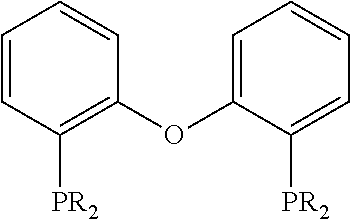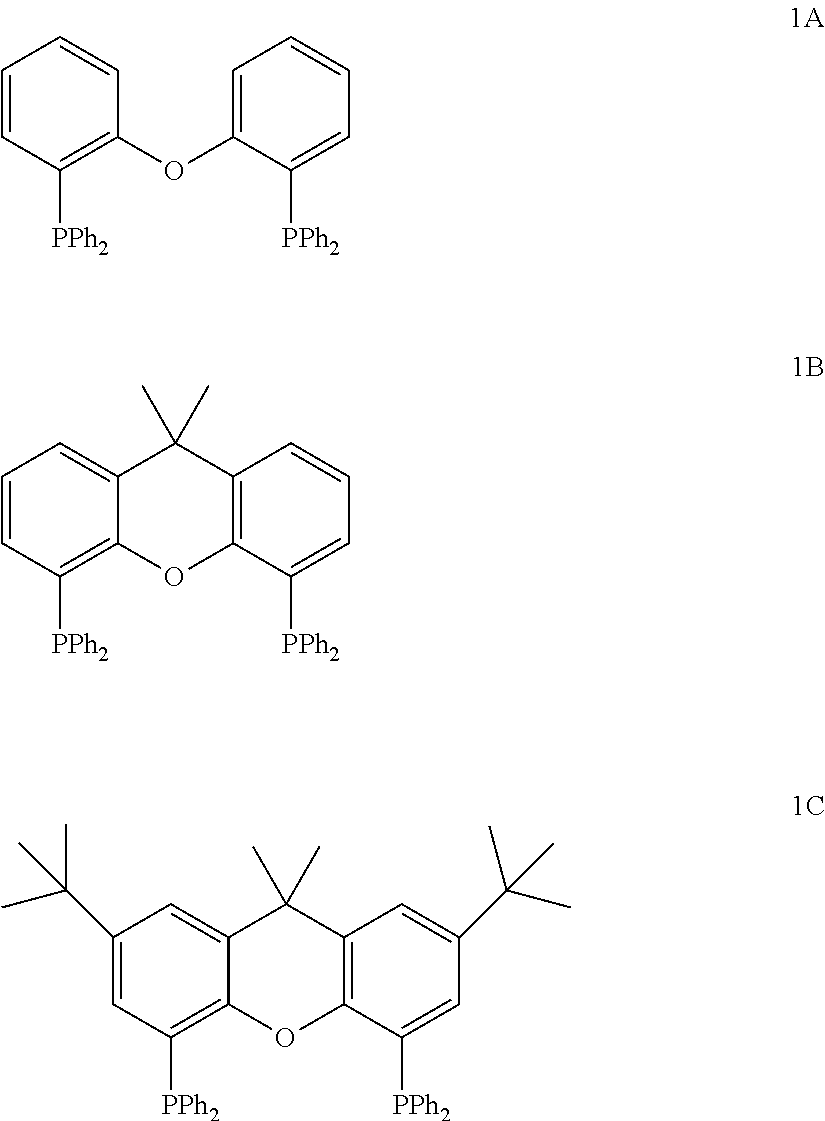Allyl acetate hydroformylation process
a technology of allyl acetate and hydroformylation process, which is applied in the preparation of carboxylic acid esters, chemistry apparatus and processes, and organic chemistry, etc. it can solve the problems of mpd co-products reducing the yield of bdo, and severe adverse effects on process economics, and achieves high ratios of 4-acetoxybutyraldehyde products
- Summary
- Abstract
- Description
- Claims
- Application Information
AI Technical Summary
Benefits of technology
Problems solved by technology
Method used
Image
Examples
example 1
Preparation of Diphosphines
[0025]1A, 1B, and 1C: Diphosphines 1A, 1B, and 1C of the following formulas are prepared as described below.
[0026]Diphosphine 1A: 2,2′-bis(diphenylphosphino)diphenyl ether.
[0027]At room temperature under argon, a solution of sec-BuLi (22 mL, 1.3 mol dm−3, 0.029 mol, 3 eq) in hexane is added dropwise to a stirred solution of diphenyl ether (1.6 g, 9.5×10−3 mol, 1 eq) and tetramethylethylenediamine (TMEDA, 3.4 g, 0.029 mol, 3 eq) in dry degassed diethyl ether and stirred for 16 hours. A solution of chlorodiphenylphosphine (5.2 mL, 0.029 mol, 3 eq) in hexane is then added dropwise, and the reaction mixture stirred for a further 16 hours. The solvent is removed under reduced pressure, and the resulting oil dissolved in CH2Cl2, washed with water and dried with MgSO4. The solvent is removed under reduced pressure, and the resulting yellow oil is recrystallized from ethanol to yield 2,2′-bis(diphenylphosphino)diphenyl ether.
[0028]Diphosphine 1B: 9,9-dimethyl-4,5-...
example 2
Hydroformylation Reaction using Phosphines
[0036]Allyl acetate is hydroformylated using diphosphines 1A-1F and triphenyl phosphine 1G according to the following procedure:
[0037]A solution of the desired phosphine (2 equivalents or 8.6×10−5 moles) in dry degassed toluene (15 g) is added to [Rh(CO)2(acac)] (1 equivalent or 4.3×10−5 moles) in a 100 mL Parr autoclave. The solution is flushed three times with a 1:1 CO / H2 mixture and then pressurized to 180 psig with the CO / H2 mixture. The autoclave is then heated to 65° C. with stirring, allyl acetate (3.5 mL) is injected, and the autoclave is pressurized to 200 psig with the CO / H2 mixture. The autoclave is kept at a constant pressure of 200 psig, and the gas uptake of the reaction is monitored. When there is no further gas uptake, the autoclave is cooled and depressurized. The resulting solution is analyzed by gas chromatography to determine the products of the reaction. The reaction produces ABA, AMPA, C3 products (acetates of propylene...
PUM
| Property | Measurement | Unit |
|---|---|---|
| soluble | aaaaa | aaaaa |
| molar ratio | aaaaa | aaaaa |
Abstract
Description
Claims
Application Information
 Login to View More
Login to View More - R&D
- Intellectual Property
- Life Sciences
- Materials
- Tech Scout
- Unparalleled Data Quality
- Higher Quality Content
- 60% Fewer Hallucinations
Browse by: Latest US Patents, China's latest patents, Technical Efficacy Thesaurus, Application Domain, Technology Topic, Popular Technical Reports.
© 2025 PatSnap. All rights reserved.Legal|Privacy policy|Modern Slavery Act Transparency Statement|Sitemap|About US| Contact US: help@patsnap.com



